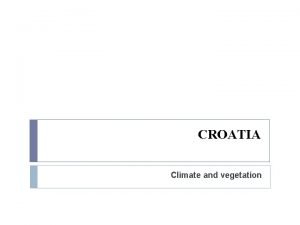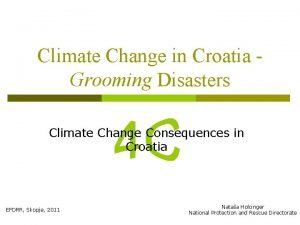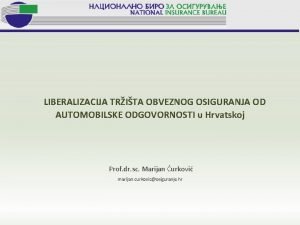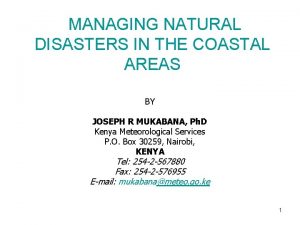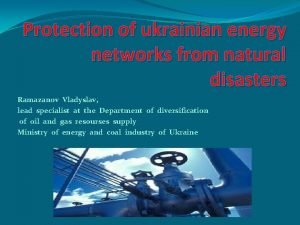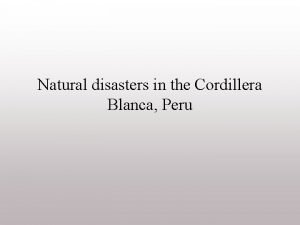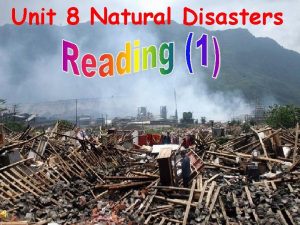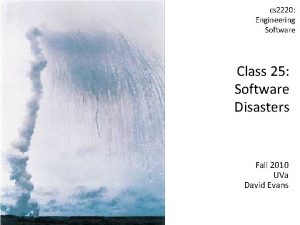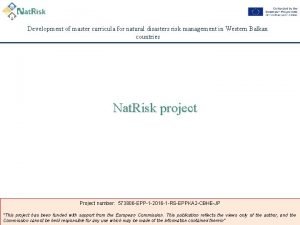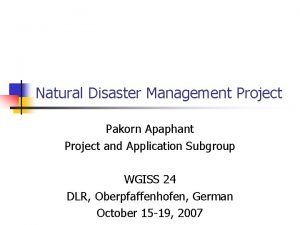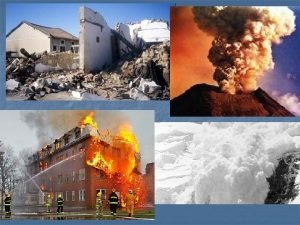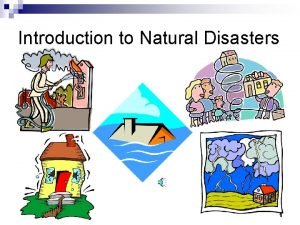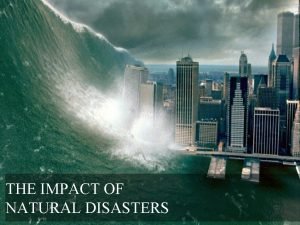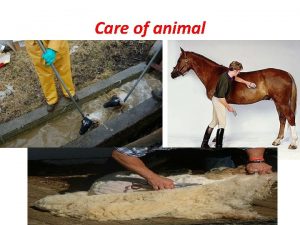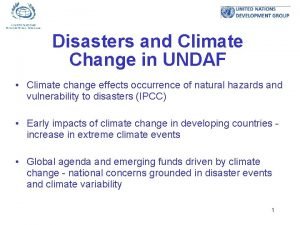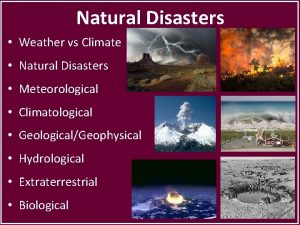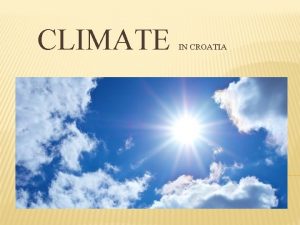Climate Change in Croatia Grooming Disasters Climate Change





































- Slides: 37

Climate Change in Croatia Grooming Disasters Climate Change Consequences in Croatia EFDRR, Skopje, 2011 Nataša Holcinger National Protection and Rescue Directorate

Climate in Croatia Köppen classification Hot-summer Mediterranean climate (Csa) Hot, humid summers and mild to cool winters (Cfa) Warm, humid summers and mild to cool winters (Cfb) Cold continental climate without dry season (Df)

Climatic Diversity in Croatia Insolation duration Large spatial differences between continental lowland, transitional mountainous region and Adriatic coast Precipitation Air temperature Relative humidity Zaninović, K. , Gajić-Čapka, M. , Perčec Tadić, M. i dr. , 2008: Klimatski atlas Hrvatske / Climate atlas of Croatia 1961 -1990. , 1971 -2000. Državni hidrometeorološki zavod, Zagreb, 200 str.

Climate change in Croatia during 20 th century and at the beginning of 21 st century § Air temperature Five meteorological stations in different climatic regions: Zagreb-Grič, Crikvenica, Osijek, Gospić, Hvar Increase of mean annual air temperature, which in the 20 th century was between +0. 02°C per 10 years in Gospić up to +0. 07°C per 10 years in Zagreb, continued and amplified by the beginning of the 21 st century § Prevailing positive trend has become particularly expressed within the last 50 years, even more within the last 25 years § The positive temperature trends in the continental part of Croatia is mostly due to winter trends, while on the Adriatic to summer trends. § Out of ten warmest years since the beginning of the 20 th century, since 2000, there were 7 recorded in Zagreb, 6 in Gospić and Crikvenica, 5 in Hvar and 4 in Osijek. § Within the whole analyzed period, a majority of warm temperature indices has a positive trend, while a majority of cold temperature indices has a negative trend § Trends are much more expressed at the Adriatic, than in the inland, except in Zagreb, where they were probably partly a result of urban heat island impact. § Almost all trends by 2008 have been amplified, and changes in trends of warm temperature indices are greater than changes in trends of cold indices. Temperature trends (°C/10 yrs), 1901 -2008 OS ZG GO CR HV DJF 0. 60 1. 25 1. 33 0. 76 0. 39 MAM 0. 50 1. 09 0. 46 0. 40 0. 52 JJA 0. 55 0. 92 0. 39 1. 34 0. 71 SON 0. 30 0. 70 0. 25 0. 85 0. 50 A 0. 50 0. 99 0. 58 0. 85 0. 56 Trends in mean annual temperature Fifth National Communication of the Republic of Croatia under the United Nation Framework Convention on the Climate Change, Ministry of Environmental Protection, Physical Planning and Construction, 137 -143. http: //unfccc. int/national_reports/annex_i_natcom/submitted_natcom/items/4903. php

Climate change in Croatia during 20 th century and at the beginning of 21 st century Precipitation trends (%/10 yrs), 1901 -2008 Precipitation § There has been drying all over Croatia on annual scale - more pronounced at the coast than in the mainland - Primorje: in all seasons - Dalmacija: winter and spring - Lika: winter and spring - north from the Sava River: spring and autumn OS ZG GO# CR HV DJF -0. 0 -0. 4 -2. 9 -1. 6 -2. 9 MAM -3. 2 -0. 9 -1. 8 -1. 9 -1. 3 JJA +1. 3 +1. 1 +0. 1 -2. 9 +2. 9 SON -2. 0 -1. 3 -0. 2 -1. 1 -0. 5 A -0. 8 -0. 3 -1. 0 -1. 7 -1. 0 § Decrease in interannual variability is mainly indicated § In the area of drying such as Croatia there is no signal of major secular changes in extremes related to the high amounts of precipitation and frequency of rainy and very rainy days over the larger part of Croatia. § The reduction in annual amounts of precipitation can be attributed to changes in the frequency of low-intensity rain days and significant increase in incidence of dry days all over Croatia. § There is the predominant increase in dry spells in the Adriatic and poorly pronounced trend in the continental area Fifth National Communication of the Republic of Croatia under the United Nation Framework Convention on the Climate Change, Ministry of Environmental Protection, Physical Planning and Construction, 137 -143. http: //unfccc. int/national_reports/annex_i_natcom/submitted_natcom/items/4903. php

CCi. C Climate Predictions p In general, Croatia is predicted to get warmer and drier – especially during the summer. p Surface snow in northern Croatia will become uncertain. p Soil moisture in the spring is expected to drop. UNDP’s National Human Development Report 2008

CCi. C Extreme weather conditions: p Floods p Droughts p Heath waves (long-term) p Thunderstorms

CCi. C CC effect: Tourism p p p Contributes significantly to human development in Croatia through the jobs and incomes that it creates for people. In Croatia, climate is especially important for tourism. The Adriatic is an ideal place for enjoying the sea during the summer months. Most tourism takes place outdoors. Hotter day-time temperatures along the Adriatic coast are expected to cause many beach tourists to avoid these destinations in favor of cooler locations to the north. Specific natural sites may also be at risk due to climate change – study is required into the probable physical impacts of climate change on specific areas (e. g. Plitvice) Health Impacts p p Events such as heat waves – likely to increase in frequency due to climate change – have had an impact on Croatians. Every year during the summer there are several deaths caused by extreme temperatures. Therefore, it is very likely that climate change will have an impact on human health in Croatia both bad and good – UNDP’s National Human Development Report 2008

CCi. C Fresh-water Resources p During summer months, 30% less precipitation p Dying of oak trees and other species in drought areas p Generation from hydro lower for 20 -50% until 2100 UNDP’s National Human Development Report 2008

CCi. C Agriculture p Looking at the future effect of climate change on maize alone, the lost revenue due to climate change would be dramatic. p Little information is available to aid in understanding or adapting to current climate variability or future climate change. UNDP’s National Human Development Report 2008

HEAT WAVE AND DROUGHT 2003.

CCi. C p Situation - may Source: MHS

CCi. C p Situation - june Source: MHS

CCi. C p Situation - july Source: MHS

CCi. C p Situation - august Source: MHS

CCi. C Already perceived climate change p p The same year, electricity production from hydro power plant's in Croatia dropped 20 % – cost was 96 mil EUR to compensate losses Extreme weather events in period 2000 – 2007 resulted in an average annual costs of 176 mil EUR for agriculture – amount higher that amount paid for incentives in agriculture within that period UNDP’s National Human Development Report 2008

CCi. C Aftermath p p p US$ 330 000 economic damage (2003. ) 30 -50 % decrease crop output Unspecified damage to freshwater fish industry Widening of the forest fires area from the coast to the inland (central Istria, Lika region, inland part of Dalmatia) Extension of the wildfires season (in 1990 -es from the end of May to the end of August, now from February to the end of September)

CCi. C Actions taken p p p US$ 50 000 (2003. ) Croatian waters and local communities starts to work on modernizing old and build new irrigation systems Every day medical advices

FLOODS CENTRAL AND EASTERN CROATIA 2010.

CCi. C p Situation - may

CCi. C p Situation - june

CCi. C Situation p from 30 May 2010 to 26 June 2010 p very high water waves of regional proportions in the river basins of international rivers Drava, Sava and the Danube p extremely high inflow of rivers from the Republic of Hungary and the area of Bosnia and Herzegovina coincided with extremely high precipitation in the area of Eastern Croatia that, in a short amount of time, reached the quantity of 180 mm/m 2, p the Baranja region had more than 710 mm/m 2 of precipitation.

CCi. C Aftermath p great damage to agriculture, fruit and vegetable growing, animal husbandry, infrastructure, property of the populations and property of local self-government units p p 427 houses, cellars and yards have been flooded 682 houses have been directly threatened and damaged 112 families have been evacuated p 7 counties p

CCi. C Economic loss and expenses (Damages) p EUR 153. 039. 302, 69 (66% of the original income of the affected counties) p Agriculture, animal husbandry, fruit growing, single construction buildings n p Temporary accommodation n p EUR 136. 335, 78 Cleaning potable water wells, cellars, yards etc. n p EUR 2. 851, 39 Rescue teams n p EUR 141. 368. 441, 69 EUR 209. 472, 54 Energy, water and waste water infrastructure, transport and preventive infrastructures n EUR 11. 322. 201, 29

CCi. C Actions taken p Irrigations system p Drainage system p 23, 69% damages verified by the Government p Amount form the EUSF: EUR 3 825 983

CCi. C Coastal Zone and Sea Level Rise p Global sea level is expected to rise between 9 and 88 cm by 2100 but there is significant uncertainty. p The analysis suggests that the amount of land under water would be over 100 million m 2 with a sealevel rise of 50 cm. p While the impacts could be very costly, they are uncertain and will occur over a fairly long time span. UNDP’s National Human Development Report 2008

COSTAL CITIES FLOODING

CCi. C Pula – 2009. p p Precipitation – 50 mm/2 h Spatial planning – concrete, asphalt but no green areas Development– 400 l/s, collection and purification system could not manage that kind amount of water, old sewerage system Adriatic coast

CCi. C Dubrovnik Foto: Željko Tutunjević

CCA – Ministry of Environmental Protection, Physical Planning and Construction CCA responsible bodies: p p p Ministry of Environmental Protection, Physical Planning and Construction Environmental Protection and Energy Efficiency Fund Croatian Environment Agency Croatian Chamber of Economy Ministry of Agriculture, Fisheries and Rural Development Ministry of Economy, Labor and Entrepreneurship Ekonerg - Energy and Environmental Protection Institute Energy Institute Hrvoje Požar Faculty of Agriculture Faculty of Mechanical Engineering and Naval Architecture Meteorological and Hydrological Service

CCA – Ministry of Environmental Protection, Physical Planning and Construction Legislation: p p p p Air Protection Act Regulation on the quality of biofuels Regulation on the quality of petroleum-derived liquid fuels Regulation on the monitoring of greenhouse gas emissions in the Republic of Croatia Regulation on limit values for pollutant emissions from stationary sources into the air Guide for the implementation of the Regulation on limit values of pollutant emissions from stationary sources into the air, Chapter VI Regulation on emission quotas for certain pollutants in the Republic of Croatia Regulation on implementation of the Kyoto Protocol flexible mechanisms Regulation on greenhouse gas emission quotas and the method of emission allowance trading Regulation on amendments to the Regulation on greenhouse gas emission allowances and emissions trading Decision on the adoption of the National Plan for the implementation of Stockholm Convention on Persistent Organic Pollutants Decision on adopting the Plan on reduction of emissions of sulphur dioxide, nitrogen oxides and particulate matter from major combustion plants and gas turbines in the territory of the Republic of Croatia Plan on allocation of greenhouse gas emission quotas in the Republic of Croatia (National Allocation Plan) Programme for gradual emission reduction of certain pollutants in the Republic of Croatia for the period until the end of 2010, with emission projections for the period 2010 -2020

CCA – Ministry of Environmental Protection, Physical Planning and Construction Reports: p The First National Communication of the Republic of Croatia to the United Nations Framework Convention on Climate Change (UNFCCC) p Croatian GHG Projections for the period 1990 -2020 p Second, Third and Fourth National Communication of the Republic of Croatia under the United Nations Framework Convention on Climate Change p National Inventory Report 2007 on Greenhouse Gas Emissions in the period 19902005 p Fifth National Communication of the Republic of Croatia under the United Nation Framework Convention on the Climate Change p Preparation of the Impact, Vulnerability and Adaptation Strategy (IVAS) to Climate Change p Croatia does not yet have a CCA Strategy

CCA – National Protection and Rescue Directorate National Platform for Disaster Risk Reduction supporting CCA p 2009. Early Warning System and the Role of Meteorological and Hydrological Service, dr. sc. Branka Ivančan-Picek - Meteorological and hydrological service of Croatia Possibilities and Restrictions of the Severe Weather Forecast, Dr sc Vlasta Tutiš - Meteorological and hydrological service of Croatia Water as Natural Disaster Generator, dr. sc. Dušan Trninić - Meteorological and hydrological service of Croatia Project of Risk Identification and Land-Use Planning for Disaster Mitigation of Landslides and Floods in Croatia, Prof. dr. sc. Ognjen Bonacci, Prof. dr. sc. Ivica Kisić, Prof. dr. sc. Nevenka Ožanić, Faculty of Civil Engineering, Faculty of Agriculture Functions of Ecological management in Risk Control, Dr. sc. Sanja Kalambura, Alen Stranjik, dipl. ing. , University of Applied Sciences Velika Gorica Flooding forecast for the Croatian Coast – Task of the Operational Oceanology, Nenad Leder, Nenad Domijan, Zvonko Gržetić, Hydrographic Institute of the Republic of Croatia

CCA - NPRD p 2010. Gale-Force Wind in Croatia, Alica Bajić, Meteorological and hydrological service of Croatia Forecasting and following thunderstorms by means of satellite and other remote sensing data, Nataša Strelec Mahović - Meteorological and hydrological service of Croatia The Influence of meteorological parameters on the acute neurovegetative disability, Ksenija Zaninović, Meteorological and Hydrological Service Precipitations risk assessment in Croatia, Marjana Gajić-Čapka (Ksenija Cindrić), Meteorological and Hydrological Service Holistic Model for Forest Fire Protection in the Adriatic Area, Darko Stipaničev (Ranko Vujčić, Branimir Hrasnik, Tomislav Vuko), University of Split Faculty of Electrical Engineering, Mechanical Engineering and Naval Architecture; Department for Economy, Development and Reconstruction of Splitsko-dalmatinska County; UZOR – Sustainable Development Association; National Protection and Rescue Directorate Changes in Extreme Climate Parameters of Future Climate Resulting from Climate Simulations Using Regional Climate Model, Mirta Patarčić (Č. Branković, L. Srnec, I. Güttler), Meteorological and Hydrological Service

CCA - NPRD NP Conference Conclusion: p In order to adapt to climate change, which the Republic of Croatia and the region is exposed to, it is necessary to increase investment in climate modeling, forecasting and analysis to support the sectoral planning in the sectors facing this risk.

CCA - NPRD Action: NPRD Informing the Public p Supporting the RC CCA Network Tasks: p § § § Advocating and influencing decision makers on the necessity of climate change adaptation through different ways of communication. Raising awareness of decision making level and general public level about necessity of Climate Change Adaptation and damage control of Climate Changes trough public campaigns, press releases and other activities in order to reduce vulnerability. Coordination and cooperation between Civil Society Organizations, governmental institutions on all levels of local and regional self-government in the Climate Change Adaptation field, technological consulting and indicating best practices examples. Information exchange between Network members on practical and expert level Information exchange between Network members about activities on Climate Change Adaptation on regional and international level. NP p Committee for CCA formed in 2011.

CCA - NPRD A way to go? p p National Risk Assessment National DRR Strategy (Accepted by the Government, and with obligatory assignments) National CC Assessment National CCA Strategy (Accepted by the Government, and with obligatory assignments)
 Albicila
Albicila Croatia koppen climate
Croatia koppen climate Climate change 2014 mitigation of climate change
Climate change 2014 mitigation of climate change Soc croatia
Soc croatia Carnival croatia
Carnival croatia Rwe
Rwe Herzegovina bulgaria croatia
Herzegovina bulgaria croatia Croatia osiguranje prijenos bonusa
Croatia osiguranje prijenos bonusa Croatia minimum wage
Croatia minimum wage Ministry of agriculture croatia
Ministry of agriculture croatia Longest river in croatia
Longest river in croatia Ministry of agriculture croatia
Ministry of agriculture croatia Natural disaster unit 9
Natural disaster unit 9 Natural disasters definition
Natural disasters definition Conclusion on disaster management ppt
Conclusion on disaster management ppt Cordillera natural disasters
Cordillera natural disasters Unit 8 natural disasters
Unit 8 natural disasters Man-made disasters introduction
Man-made disasters introduction Types of disasters
Types of disasters Software engineering disasters
Software engineering disasters Ancient natural disasters
Ancient natural disasters Define natural disaster
Define natural disaster Accidents & disasters
Accidents & disasters Natural hazards vs natural disasters
Natural hazards vs natural disasters Natural disasters
Natural disasters Listening about natural disasters
Listening about natural disasters Three natural disasters
Three natural disasters Conclusion of disaster management
Conclusion of disaster management What are disasters
What are disasters Accidents & disasters
Accidents & disasters Hailmap
Hailmap English language paper 2 rail disasters mark scheme
English language paper 2 rail disasters mark scheme Social impact of natural disasters
Social impact of natural disasters Natural disasters
Natural disasters Conclusion of natural disasters
Conclusion of natural disasters Most historians agree that military disasters
Most historians agree that military disasters What is the role of government in disaster management
What is the role of government in disaster management Helike greece
Helike greece
